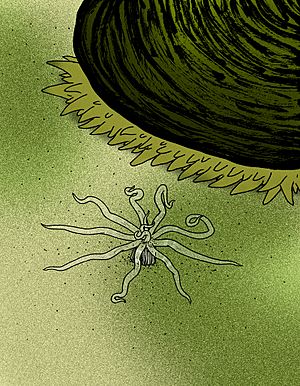Ivell's sea anemone facts for kids
Quick facts for kids Ivell's sea anemone |
|
|---|---|
 |
|
| Artist's image of the living animal | |
| Conservation status | |
| Scientific classification |
The Ivell's sea anemone (Edwardsia ivelli) is a special type of sea anemone. It belongs to the Edwardsiidae family. This tiny creature is found in only one place in the world! That place is Widewater Lagoon in West Sussex, England. Richard Ivell first discovered it there. Since 1996, experts have listed it as "Data Deficient" by the IUCN. This means we don't have enough information to know how many are left.
Contents
What Ivell's Sea Anemone Looks Like
Ivell's sea anemone is very small. It looks a bit like a tiny worm. It can grow up to 20 millimeters (about 0.8 inches) long. It is only about 1.5 millimeters (0.06 inches) wide.
Its Body and Tentacles
Its main body part, called the column, looks like other Edwardsia sea anemones. It has twelve clear tentacles. These tentacles are arranged in two groups. Nine tentacles are in the outer group. Three tentacles are in the inner group.
When it is alive, the outer tentacles lie flat. The three inner tentacles usually stand up. They often curl over its mouth. Each tentacle has light cream-colored stripes. Sometimes these stripes form full rings.
Where Ivell's Sea Anemone Lives
This sea anemone is found only in England. It lives in just one spot: Widewater Lagoon in West Sussex. This is the only place it has ever been found.
Is It Still There?
Sadly, people have searched for it in recent years. They have not found any Ivell's sea anemones. Because of this, some experts think the species might be extinct. This means it might have completely disappeared from the Earth.
Ivell's Sea Anemone's Home
This tiny creature likes to burrow. It lives in soft mud. You can find it in salty lagoons or calm, sheltered creeks. Because it is so small, it is easy to miss. You have to look very carefully to find it!
Similar Sea Anemones and Why They Need Our Help
Divers do not often explore the places where this sea anemone lives. But these areas are very interesting to study.
Ivell's sea anemone and the Nematostella vectensis are important. They are probably the only British Anthozoans that are in danger. They are threatened by their homes being destroyed. Pollution also harms them.
Professor Richard Ivell discovered Ivell's sea anemone. That is why it was named after him!


